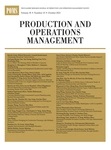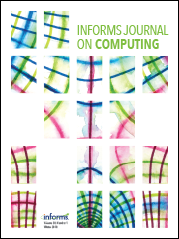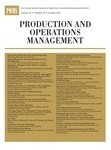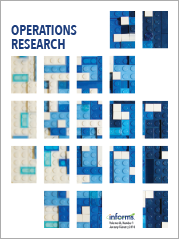SCHOLARLY ARTICLES
-

CSR orientation incongruence and supply chain relationship performance—A network perspective
Firms’commitment to corporate social responsibility (CSR) can be a crucial factor in supply chain partnerships. This study examines the effect of CSR orientation incongruence on relationship performance. Drawing on the congruence theory literature, we posit that a firm's relationship performance may suffer when there is incongruence between the levels of CSR orientations of supply chain partners. Furthermore, we adopt a network perspective and argue that certain characteristics of a firm's egocentric social network (i.e., network centrality and network diversity) may moderate the linkage between CSR orientation incongruence and relationship performance. Our empirical study, which is based on dyadic data, indeed reveals that a firm's relationship performance is adversely affected when the firm and its major supply partner have incongruent levels of CSR orientations. Such a negative effect is moderated by the firm's egocentric social network. Specifically, the negative impact of incongruent CSR orientation is heightened if the firm occupies a central position in the egocentric network. Network diversity, however, plays a contrasting role as a firm's relationship performance may be less susceptible to incongruent CSR orientations when there is access to a diverse social network.
-

Constant Job-Allowance Policies for Appointment Scheduling: Performance Bounds and Numerical Analysis
We consider the classical appointment scheduling problem that does not have a session length constraint. The decision is to determine job allowances to minimize total expected weighted costs of waiting times of jobs and idle times of the service provider. In particular, we study a simple yet effective scheduling policy-the so-called "constant" policy, which allocates a constant job allowance for each appointment. Prior studies on appointment scheduling suggest a "dome"-shaped structure for the optimal job allowance over the planning horizon. This implies that job allowance does not vary significantly in the middle of the schedule sequence, but varies at the beginning as well as the end of the optimal schedule. We show that an even simple scheduling policy-the constant policy, is asymptotically optimal thus provide theoretical justification for such a widely used policy. Using a dynamic programming formulation, we express each job's waiting time as the maximum of a random walk, which allows us to bound the performance gap between the constant policy and the optimal schedule based on classical results on D/G/1 queues. We derive an explicit upper bound for the performance gap when either of the following conditions holds: (i) the server idling cost is relatively small compared to the job waiting cost, and (ii) the number of appointments is sufficiently large. We also extend this result to a more general setting with multiple service types. Numerical experiments show that the constant policy is near optimal even when the number of appointments is small or when the server idling cost is moderately large, which complements our theoretical results. Our result provides a justification and strong support for the constant policy under certain mild conditions. Moreover, with minor modifications, the constant policy can be adapted to more general scenarios with patient no-shows, or with heterogeneous appointment types.
-

Estimation of a SAR model with endogenous spatial weights constructed by bilateral variables
autoregressive (SAR) model with spatial weights constructed by bilateral variables like the trade or investment between regions. We model the possible endogeneity in spatial weights due to the correlation between the error term in the SAR model and unobserved interactive fixed effects in bilateral variables. Using a control function approach, we propose two-stage estimation methods and establish their consistency and asymptotic normality. Finite sample properties are investigated by a Monte Carlo study. We further apply our method to an empirical study of interactions among different US industries through production networks. (c) 2020 Elsevier B.V. All rights reserved.
-

Ranking and Selection with Covariates for Personalized Decision Making
We consider a problem of ranking and selection via simulation in the context of personalized decision making, in which the best alternative is not universal, but varies as a function of some observable covariates. The goal of ranking and selection with covariates (R&S-C) is to use simulation samples to obtain a selection policy that specifies the best alternative with a certain statistical guarantee for subsequent individuals upon observing their covariates. A linear model is proposed to capture the relationship between the mean performance of an alternative and the covariates. Under the indifference-zone formulation, we develop two-stage procedures for both homoscedastic and heteroscedastic simulation errors, respectively, and prove their statistical validity in terms of average probability of correct selection. We also generalize the well-known slippage configuration and prove that the generalized slippage configuration is the least favorable configuration for our procedures. Extensive numerical experiments are conducted to investigate the performance of the proposed procedures, the experimental design issue, and the robustness to the linearity assumption. Finally, we demonstrate the usefulness of R&S-C via a case study of selecting the best treatment regimen in the prevention of esophageal cancer. We find that by leveraging disease-related personal information, R&S-C can substantially improve patients' expected quality-adjusted life years by providing a patient-specific treatment regimen.
-

Managing a Hybrid RDC-DC Inventory System
In this study, we study a hybrid RDC-DC serial inventory system where the regional distribution center (RDC) replenishes its stock from an outside supplier (OS), while the distribution center (DC) faces random demand and replenishes its stock from the RDC. Unlike in the traditional serial system, the DC itself can replenish its inventory from outside as well. We firstly derive structural properties for the optimal long-run average cost and the optimal stationary policy by vanishing discount approach, and then propose two simple and easy-to-implement policies. The first policy, which we call the three-index policy, combines the characteristics of the echelon-base-stock policy for the serial system (Clark and Scarf. 1960. Management Sci.6(4): 475-490) and the dual-index policy for the dual-sourcing system (Veeraraghavan and Scheller-Wolf. 2008. Oper. Res.56(4): 850-864). We show that the order-up-to level of the DC from the RDC can be computed by a newsboy fractile. A simulation-based optimization procedure for the policy is provided. We then develop the approximate linear programming (ALP) policy based on the three-index policy and the multimodularity of the problem. This policy applies the linear programming approach to approximately solve the value function of the dynamic programming formulation. Numerical results show that both the three-index policy and the ALP policy are comparable to the optimal policy computed via dynamic programming, and the latter performs slightly better. Moreover, the OS of the DC can draw considerable cost savings under both policies. We also conduct a numerical study with problem parameters calibrated using actual data from a consumer goods company in China to glen insights on the management of the system.
-

Technical Note-Preservation of Additive Convexity and Its Applications in Stochastic Optimization Problems
In this paper, we establish two preservation results of additive convexity for a class of optimal transformation problems and a class of optimal disposal problems. For both classes of problems, there are multiple resources; our results show that if these resources have different priorities to be transformed/disposed under the optimal policy, then the additive convexity and bounded monotonicity of the objective function are preserved to the value function after optimization. A key observation is that an optimal transformation problem with prioritized optimal decisions is equivalent to a serial inventory problem with zero lead times. We demonstrate the applications of our results to several stochastic optimization problems in operations management.



